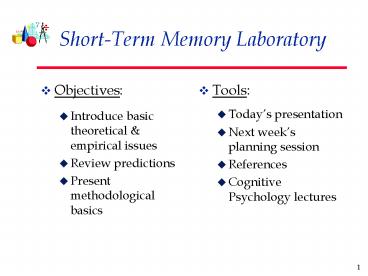ShortTerm Memory Laboratory - PowerPoint PPT Presentation
1 / 20
Title:
ShortTerm Memory Laboratory
Description:
There are severe limits on the number of unrelated verbal items that can be ... Poirier & Saint-Aubin (1996) Frequency & phonemic similarity. 6. LTM contribution ... – PowerPoint PPT presentation
Number of Views:51
Avg rating:3.0/5.0
Title: ShortTerm Memory Laboratory
1
Short-Term Memory Laboratory
- Objectives
- Introduce basic theoretical empirical issues
- Review predictions
- Present methodological basics
- Tools
- Todays presentation
- Next weeks planning session
- References
- Cognitive Psychology lectures
2
ISR and the Articulatory Loop Hypothesis.
- There are severe limits on the number of
unrelated verbal items that can be immediately
recalled in their order of presentation. - Typical paradigm used to study STM Immediate
Serial Recall or ISR - Research shows that in most conditions we can
recall approximately 7 or 2 items or about
2 seconds worth of material
3
Data Reliability
- Multiple trials per condition
- A trial one memory list to remember
- Multiple participants
- Standard conditions of testing standard
instructions.
4
Verbal Working Memory LTM...
- What is the relationship of verbal short-term
memory to LTM ? - For example, it is well established that lexical
or high-frequency items lead to superior
performance in ISR... - Word frequency / word familiarity
- Lexicality
- Semantic category
- Concreteness
5
Lexicality Frequency effects
- Tehan Humphreys (1988)
- Frequency, word class, suppression
- Gregg, Freedman, Smith (1989)
- Frequency suppression.
- Poirier Saint-Aubin (1996)
- Frequency phonemic similarity
6
LTM contribution ...
- A two-stage account of ISR performance where
- A list sets up a phonological representation in
working memory that begins to degrade rapidly. - At recall, degraded representations are
reconstructed or interpreted by calling upon
long-term verbal knowledge - Highly familiar items are more accessible
7
A finer grained hypothesis...
- This leads to the prediction that high
familiarity, lexical, etc. items will lead to
better item information recall - All else being equal, such items will have a
higher probability of being recalled based on a
degraded representation. - Predictions of the redintegration hypothesis when
high low familiarity items are mixed are not
supported.
8
Alternative Item Order hypothesis
- In ISR, performance is a function of a trade-off
between encoding item specific information and
relational information. - Low frequency / familiarity items promote item
information encoding at the expense of order
information encoding.
- ISR calls upon order encoding for good
performance - Hence recall is better for highly
familiar items. - Recognition better for low-frequency items
- MIXED LISTS ISR
- Order recall more equated
- Differences should disappear or reverse
9
Tests of the item-order hypothesis
- Paradigm 1
- Frequency x list type
- High-low freq
- Pure lists vs. mixed lists.
- Immediate serial recall
- Paradigm 2
- Frequency x list type
- High-low freq
- Pure lists vs mixed lists.
- Missing item task
10
Design Materials P1
- 4 conditions High in pure lists, Low in pure
lists, High in mixed lists, Low in mixed lists. - 4 blocks of trials 1 high pure, 1 low pure, 2
mixed. - 6 or 7 items per list
11
Design Materials
- 10 to 18 lists per condition
- lists have to be recalled (ISR) or one item
recalled in missing item task - Controls
- Word-length, concreteness, imageability, phonemic
similarity, semantic category
12
Item Order scoring
- pontoon lagoon racoon spoon platoon
dragoon - pontoon lagoon spoon XX dragoon platoon
- 1 1 0 0 0 0
- 1 1 1 0 1 1
- Lenient scoring 5, it follow that Item errors
1 - Strict scoring 2
- Order errors (5-2) 3, but often proportions
important
13
Research Methods - Lab 1
- The devil is in the details
14
Definition
- To clarify - a trial includes the presentation of
a to-be-remembered list and the response to that
list. - Each condition in your experiment should include
many trials -- at least 8 to 10.
15
Steps to accomplish
- Selection of the stimuli for inclusion in your
study. - How many words do you need?
- What characteristics should they have?
- Word length to avoid floor ceiling effects
- Difference in frequency introduced
- Pre-testing a good idea
- MRC database
- Excel good tool also
16
Steps
- Construction of the lists for each condition
- Probably preferable to use the same words in the
pure mixed conditions - Counterbalancing of conditions?
- Preparation of instructions, practice trials, and
experimental trials.
17
Stimulus presentation
- Most years, stimuli are presented through
PowerPoint - Timing capacities of the software can be called
upon - Instructions response sheets needed
18
Data scoring
19
Data Input
20
Serial position analyses possible

